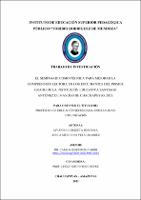| dc.contributor.advisor | Dr. Carlos Jesús Reina Mori | es_PE |
| dc.contributor.author | CHUQUIZUTA MENDOZA, Livani | es_PE |
| dc.contributor.author | VELA GRANDEZ, Adela Mercedes | es_PE |
| dc.date.accessioned | 2025-07-23T22:51:46Z | |
| dc.date.available | 2025-07-23T22:51:46Z | |
| dc.date.issued | 2023-12-28 | |
| dc.identifier.uri | http://hdl.handle.net/123456789/64 | |
| dc.description.abstract | This research was developed with the aim of improving reading comprehension
in students in the first grade of secondary school. The study was carried out in a
descriptive manner with a Pre-experimental design of Test and Post-Test application,
with a single group of students. The sample population consisted of 16 students of the
aforementioned degree, taking into account the non-probabilistic sampling. The most
relevant results obtained after the application of the test and post-test indicated that
there is a significant difference in the levels of reading comprehension. In the Pre-Test,
validated by three experts, it was observed that 81% of the students were at the
beginning level in their reading comprehension, while the remaining 19% were in the
process. In the Post test, the results varied greatly, showing us that 12% of students
were in the process, 50% were at the satisfactory level, while 38% were at the
outstanding level, note that, in the Post Test, the number of students at the beginning
level was completely eliminated, these results clearly show important advances in the
three levels of reading comprehension, which clearly indicates to us, as a final
conclusion, that the technique of the Seminar substantially strengthens the different
levels of reading comprehension, at the same time that they also improve in their
management of vocabulary, as well as a better level of observation, attention, memory
and imagination, which are fundamental skills for oral expression. | es_PE |
| dc.description.tableofcontents | 1. PROBLEMA DE INVESTIGACIÓN 11
1.1. Planteamiento del Problema ...................................................................12
1.2. Formulación del Problema ..................................................................... 13
1.2.1. Problema Principal ..................................................................... 13
1.2.2. Problemas Específicos ................................................................14
1.3. Objetivos de la Investigación ................................................................. 14
1.3.1.Objetivo general ........................................................................... 14
1.3.2.Objetivos Específicos ................................................................... 14
1.4. Formulación de la Hipótesis .................................................................. 15
1.4.1.Hipótesis General ......................................................................... 15
1.4.2.Hipótesis Específicas ................................................................... 15
1.5. Justificación teórica, metodológica y práctica ....................................... 16
1.5.1.Justificación Teórica ..................................................................... 16
1.5.2.Justificación Metodológica ........................................................... 16
1.5.3.Justificación Práctica .................................................................... 17
2. MARCO TEÓRICO 18
2.1. Antecedentes de la Investigación ........................................................... 19
2.1.1.Internacional ................................................................................. 19
2.1.2.Nacional ........................................................................................ 20
2.1.3.Regional / Local ........................................................................... 22
2.2. Bases teóricas ........................................................................................ 22
2.2.1.El Seminario (Variable Independiente) ........................................ 22
2.2.2.Teorías que sustentan la comprensión lectora .............................. 26
2.2.3.Comprensión Lectora (Variable Dependiente) ............................. 27
2.3. Definición de Términos Básicos ............................................................ 33
2.3.1.Seminario como Técnica .............................................................. 33
2.3.2.Técnicas ........................................................................................ 33
2.3.3.Aprendizaje ...................................................................................33
2.3.4.Herramienta Pedagógica .............................................................. 33
2.3.5.Comprensión Lectora ................................................................... 34
2.3.6.Importancia de la Comprensión Lectora ...................................... 34
3. METODOLOGÍA DE LA INVESTIGACIÓN 35
3.1. Identificación de las Variables de Investigación ................................... 35
3.1.1.Variable Independiente: “El seminario como técnica” ................ 35
3.1.2.Variable Dependiente: “La comprensión lectora” ........................37
3.2. Tipo, nivel y diseño de la investigación ................................................. 38
3.2.1.Tipo de investigación ................................................................... 38
3.2.2.Nivel de investigación .................................................................. 38
3.2.3.Diseño de investigación ................................................................ 38
3.3. Población y muestra .............................................................................. 39
3.3.1.Población ..................................................................................... 39
3.3.2.Muestra ........................................................................................ 39
3.4. Técnicas e instrumentos de recolección de datos ................................. 40
3.5. Proceso de prueba de hipótesis y análisis de datos ............................... 41
3.5.1.Media aritmética .......................................................................... 41
3.5.2.Mediana ....................................................................................... 41
3.5.3.Moda ............................................................................................ 42
3.5.4.Desviación Estándar .................................................................... 42
4. DESCRIPCIÓN DE LOS RESULTADOS 43
4.1. Resultados ............................................................................................. 44
5. DISCUSIÓN, CONCLUSIONES Y SUGERENCIAS 53
5.1. Discusión ............................................................................................... 54
5.2. Conclusiones ......................................................................................... 56
5.3. Sugerencias ........................................................................................... 57
BIBLIOGRAFÍA ...................................................................................................... 58
ANEXOS .................................................................................................................. 61
INDICE DE TABLAS
Tabla 01: Rúbrica de Evaluación: ............................................................................38
Tabla 02: Población de estudio. ............................................................................... 41
Tabla 03: Muestra de estudio ................................................................................... 41
Tabla 04: Cálculo de la estadística descriptiva del pre test ......................................46
Tabla 05: Tabla de frecuencia porcentual por calificaciones del pre test................. 46
Tabla 06: Tabla porcentual por niveles de logro del pre test ................................... 47
Tabla 07: Tabla porcentual comparativa del pre y post test .................................... 48
Tabla 08: Cálculo de la estadística descriptiva del post test .................................... 51
Tabla 09: Tabla de porcentajes obtenidos del post test ............................................52
Tabla 10: Total porcentual por niveles de logro del post test .................................. 52 | es_PE |
| dc.format | application/pdf | es_PE |
| dc.language.iso | spa | es_PE |
| dc.relation | EL SEMINARIO COMO TÉCNICA PARA MEJORAR LA COMPRENSIÓN LECTORA EN LOS ESTUDIANTES DEL PRIMER GRADO DE LA INSTITUCIÓN EDUCATIVA SANTIAGO ANTÚNEZ DE MAYOLO DE CHACHAPOYAS 2023. | es_PE |
| dc.rights | info:eu-repo/semantics/openAccess | es_PE |
| dc.subject | Investigación | es_PE |
| dc.title | EL SEMINARIO COMO TÉCNICA PARA MEJORAR LA COMPRENSIÓN LECTORA EN LOS ESTUDIANTES DEL PRIMER GRADO DE LA INSTITUCIÓN EDUCATIVA SANTIAGO ANTÚNEZ DE MAYOLO DE CHACHAPOYAS 2023. | es_PE |
| dc.type | info:eu-repo/semantics/bachelorThesis | es_PE |
| dc.type.version | info:eu-repo/semantics/publishedVersion | es_PE |
| dc.publisher.country | PE | es_PE |
| dc.subject.ocde | https://purl.org/pe-repo/ocde/ford#5.03.00 | es_PE |
| renati.author.dni | 77231908 | |
| renati.author.dni | 65051126 | |
| renati.advisor.orcid | https://orcid.org/0009-0006-8915-2423 | es_PE |
| renati.advisor.dni | 33430014 | |
| renati.type | https://purl.org/pe-repo/renati/type#trabajoDeInvestigacion | es_PE |
| renati.level | https://purl.org/pe-repo/renati/nivel#tituloProfesional | es_PE |
| renati.juror | P: Cruz López, Fany | es_PE |
| renati.juror | S: Mori Zagaceta, German | es_PE |
| renati.juror | V: Herrera Uceda, Oscar | es_PE |
| thesis.degree.name | Profesor/a de Educación Secundaria, Especialidad: Comunicación. | es_PE |
| thesis.degree.grantor | Instituto de Educación Superior Público Pedagógico "Toribio Rodríguez de Mendoza" | es_PE |
| thesis.degree.discipline | Educación Secundaria, Especialidad: Comunicación. | es_PE |



